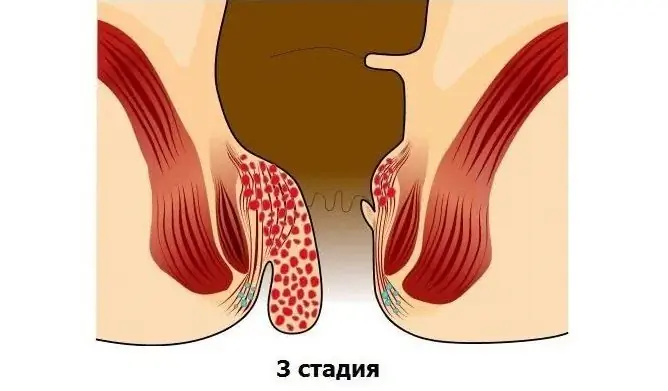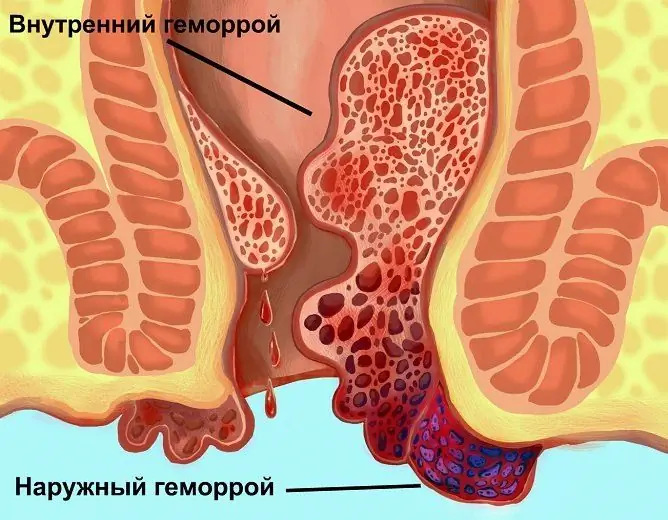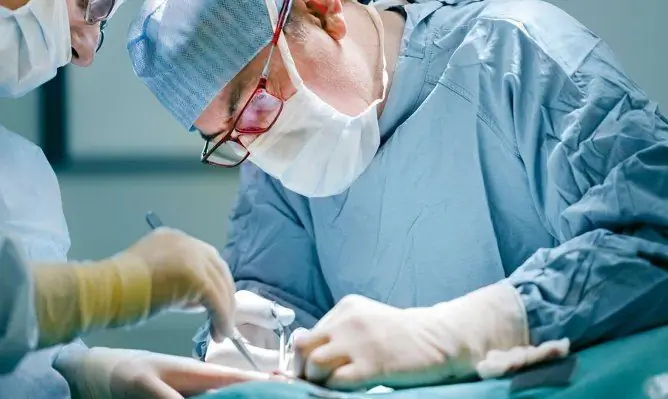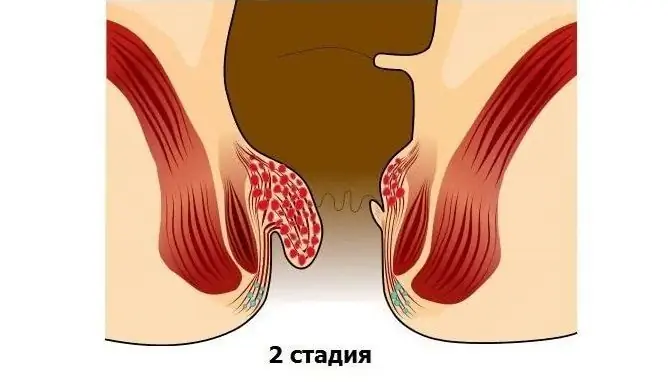- Author Rachel Wainwright [email protected].
- Public 2023-12-15 07:39.
- Last modified 2025-11-02 20:14.
Hemorrhoids 3 degrees: symptoms, diagnosis and treatment of hemorrhoids 3 stages
The content of the article:
- Symptoms of the 3rd degree of hemorrhoids
- Forms of hemorrhoids
- Diagnostics
- Hemorrhoid treatment stage 3
- Hemorrhoids treatment methods at 3 stages
- Video
Hemorrhoids of grade 3 are often diagnosed by a proctologist during the initial examination. The development of pathological changes in the cavernous tissue occurs gradually, the first manifestations of the disease are implicit, occur periodically and often go unnoticed.

Stage 3 hemorrhoids are characterized by the loss of nodes with any physical activity, while the nodes are amenable to manual reduction
As a result of impaired venous circulation in the pelvic region, the cavernous (cavernous) bodies located between the rectal arteries and veins in the anal canal area expand. Normally, these vascular formations, together with the sphincter, are involved in the retention of feces and gases in the rectum. Stagnation of blood in the perianal region leads to a loss of elasticity by the walls of the veins, an increase in the corpora cavernosa and the formation of hemorrhoids from them.
The initial, first degree of hemorrhoids is manifested by discomfort during bowel movements, itching in the anus, bulging of hemorrhoidal veins into the rectal lumen, and periodic bleeding. At stage 2, the inflammation spreads to the tissues around the affected node, a burning sensation appears, the pain intensifies, the nodes increase in size, systematically inflame and bleed. The prolapsed hemorrhoidal formations are still adjusted independently into the rectum when changing the position of the body.
If the disease is not diagnosed in time, the pathological process gradually passes into the third stage.
Symptoms of the 3rd degree of hemorrhoids
Hemorrhoids of grade 3 are said to be when hemorrhoids are no longer drawn into the rectum on their own, fall out of the anus not only during bowel movements, but also with any strenuous efforts, but can still be manually adjusted.
The third stage of hemorrhoids is characterized by the following symptoms:
- increased pain during bowel movements;
- constant itching and burning in the anal area;
- significant increase in hemorrhoids;
- prolapse of vascular formations with minimal physical exertion: sudden movements, coughing or sneezing;
- swelling of the anus;
- frequent bleeding from the anus.
Anal fissures and rectal erosion often develop. In addition, there is a risk of pinching and ischemia of the nodes with subsequent necrosis of the affected tissues, thrombosis of hemorrhoids, paraproctitis with fistula formation, anemia due to constant blood loss.
Forms of hemorrhoids
Chronic hemorrhoids are characterized by erased symptoms, a long latency period, a continuously progressive course with exacerbations. An exacerbation is manifested by a sharp sudden pain, the external bumps become inflamed and swollen, there is a burning sensation, itching and bleeding in the anal canal.
Hemorrhoids are divided into external, internal and combined, depending on the location of the hemorrhoids. With external hemorrhoids, pathological changes in the cavernous vessels are localized in the outer region of the rectum, around the anus. Internal hemorrhoids are characterized by the location of hemorrhoids under the intestinal mucosa, inside the anus. Combined (mixed) hemorrhoids are characterized by inflammation of both internal and external hemorrhoidal growths.
Diagnostics
Primary diagnosis is carried out by collecting anamnesis, visual examination and digital rectal examination. During an external examination, the proctologist may ask the patient to strain or cough strongly in order to assess the condition of the internal nodes, their bleeding, the possibility of reducing the fallen out hemorrhoids.

If it is necessary to clarify the diagnosis, they resort to instrumental research - sigmoidoscopy
Also, the doctor will prescribe a general analysis of blood and feces, laboratory and clinical studies of feces for the presence of hidden blood and mucus.
For clarifying diagnostics, instrumental methods are used:
- anoscopy - assessment of the state of the rectal mucosa, determination of changes and violations of its integrity, the presence of inflammation, cracks, erosions. The study is carried out using a special instrument - anoscope (proctoscope);
- sigmoidoscopy - examination of the rectum using a sigmoidoscope. The method allows you to see the presence of internal hemorrhoids and assess the condition of the rectum, even when the hemorrhoids are located high in the anal canal.
If necessary, prescribe additional types of research: irrigoscopy, colonoscopy, biopsy of the rectal mucosa.
Hemorrhoid treatment stage 3
How to treat grade 3 hemorrhoids? Depending on the clinical picture, the state of hemorrhoids, concomitant inflammation and complications, treatment can be conservative or surgical.
Starting from this stage, that is, when the hemorrhoids cease to independently adjust into the rectum after prolapse, it becomes problematic to cure hemorrhoids at home.
Depending on the diagnosis and the patient's condition, the proctologist prescribes complex therapy, the purpose of which is to relieve pain, normalize venous outflow and increase vascular tone, relieve itching and edema, eliminate focal inflammation and bleeding. Medicines for internal and external use are prescribed - rectal suppositories, ointments, creams. Treatment of grade 3 hemorrhoids necessarily includes adherence to a diet and exercise of therapeutic exercises aimed at eliminating blood stagnation in the small pelvis.
If conservative treatment is not effective enough, the issue of prompt removal of hemorrhoids is considered. In most cases, this can be done in 3 stages using one of the minimally invasive methods.
Hemorrhoids treatment methods at 3 stages
Is it possible to treat stage 3 hemorrhoids without surgery? This is determined by the doctor on an individual basis. In general, minimally invasive methods of removing hemorrhoids are preferable, since they are associated with significantly lower risks and do not require a long recovery period after the intervention.

Latex ligation is a minimally invasive method for the treatment of hemorrhoids, used in 3 stages
The most popular minimally invasive methods for removing hemorrhoids:
- latex ligation. During the procedure, a special elastic ring is applied to the base of the hemorrhoid using a ligator. As a result, the flow of blood to the external node stops, it dies off and is rejected by the body along with the latex ligature;
- sclerotherapy - the introduction of a sclerosant into the cavity of an internal hemorrhoidal formation, after which gluing (sclerosis) of the vessel occurs. The blood circulation in it stops, the node dies off;
- dearterization - the cessation of blood supply to the hemorrhoids by ligation of the arteries. Simultaneously with stopping the flow of arterial blood, internal nodes are fixed in the rectum;
- radio wave hemorrhodectomy - destruction of tissue nodes by high-frequency radio waves. The dissecting effect is achieved by heating tissues with waves of a certain frequency. Radio wave ablation is performed with a radio knife, using a non-contact incision technique, in which there is no contact of the electrode with the tissues;
- infrared (photo, laser) coagulation - impact on hemorrhoids with a light flux, focused infrared beam. Under the influence of light energy, proteins are denatured and blood vessels are hardened.
If treatment with a minimally invasive method is contraindicated, they resort to radical hemorrhoidectomy - surgical excision of hemorrhoids using the Longo or Milligan-Morgan method.
Video
We offer for viewing a video on the topic of the article.

Anna Kozlova Medical journalist About the author
Education: Rostov State Medical University, specialty "General Medicine".
Found a mistake in the text? Select it and press Ctrl + Enter.






